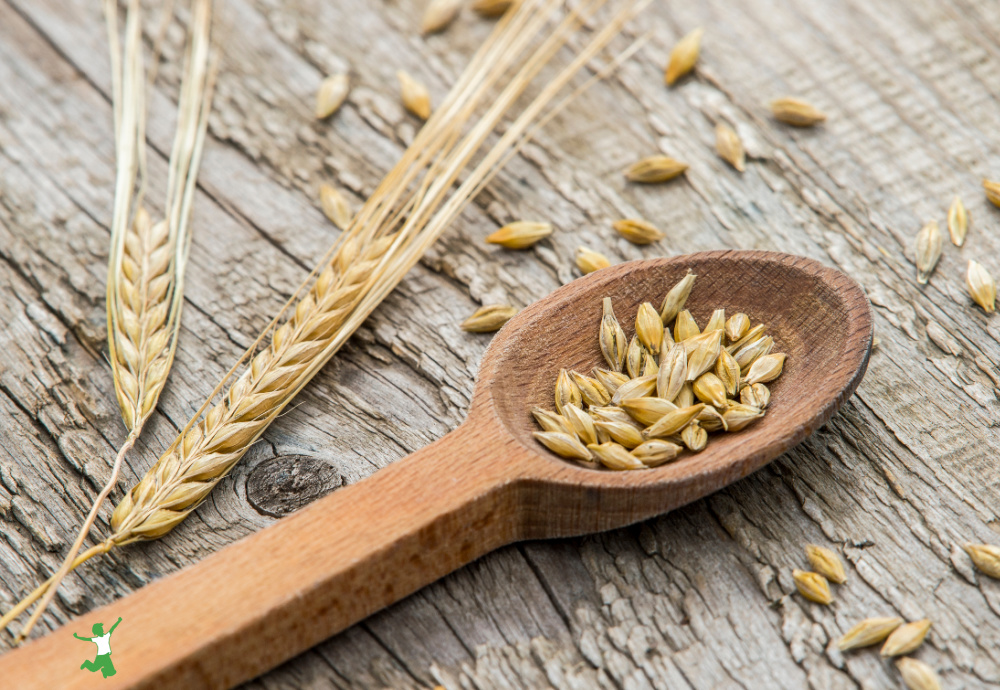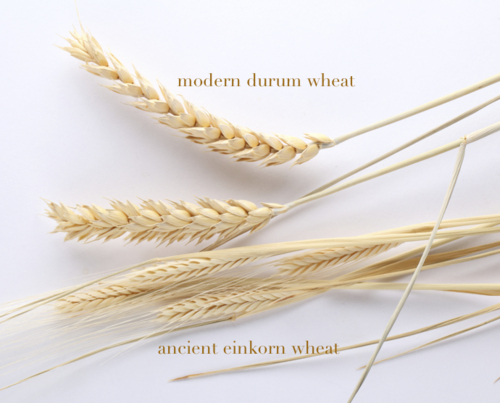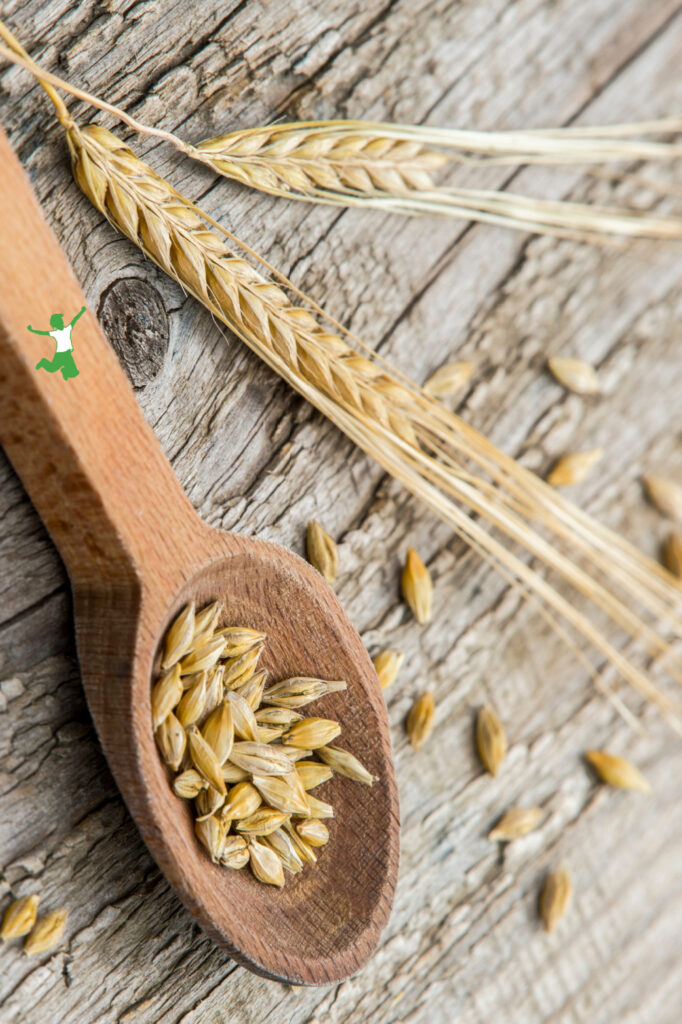There are four big reasons why einkorn is, by far, the best form of wheat to eat even when compared to other ancient grains like spelt, emmer, and kamut.

Most people who love to bake bread, pastries, and other goodies do not realize that einkorn is the best type of wheat to use.
Twenty-five or so years ago, I used to purchase organic white wheat (hard and soft) and spelt in bulk from a local grain co-op for my baking endeavors.
Grinding grain into fresh flour is certainly the most nutritious and tastiest way to bake! I also did this to avoid the conventional toxic wheat desiccated with gut-destroying glyphosate.
Caveat: Baking with freshly ground flour is only better if the bread is traditionally prepared.
Otherwise, the antinutrients like phytic acid are not broken down and harm to gut health is likely over time.
There certainly is a huge difference between modern processed wheat (hybridized by irradiation) and the organic, ancient grains you grind yourself at home.
I remember when I was breastfeeding my youngest child, if I ate so much as a mouthful or two of processed wheat at a restaurant, she would spit up for one or sometimes even two days!
If I ate organic wheat that I ground myself and either sprouted, soaked, or sour-leavened (sourdough), however, she never had any spit-up issues.
To me, this was a huge testament to the radically improved digestibility of wheat that is prepared using the wise methods of ancestral cultures.
Beware of persuasive influencers who claim that all you need to do is grind freshly ground flour and bake bread with baker’s yeast with no proper preparation such as soaking, sprouting or sour-leaving the dough necessary.
This approach is not how traditional societies ever baked their bread, and it is a recipe for serious gut issues!
Most people do not know that baker’s yeast is actually a modern invention only used in the past few centuries!
It quickly gained traction because it made baking faster and easier (NOT healthier). This is the case even when using freshly ground flour!
These quick rise breads using baker’s yeast gradually displaced traditional sourdough to the detriment of those who embraced this early “modern” cooking convenience.
Einkorn Benefits over Modern Wheat
With traditional baking the way to go (using a sourdough starter and NOT baker’s yeast), let’s talk about einkorn as the best type of wheat to bake with.
There are four reasons why I prefer to bake with einkorn wheat and no other type of ancient grains.
This isn’t to say I never use anything else, but if given the choice, I prefer to use einkorn.
Note that einkorn is not to be confused with farro or heirloom wheat.
Better Taste
My first experience baking with einkorn occurred after I received a thoughtful gift of, among other things, einkorn flour and wheat berries. I was delighted when I ground the einkorn into flour and saw how light and white it was.
I am not a fan of bran and am not of the food philosophy that all that fiber is actually good for your gut.
Fiber is a band-aid that covers up the root causes of constipation, a very common symptom of gut imbalance.
I recommend the book Fiber Menance as a good read on the subject.
The truth is that the unhybridized form of wheat…einkorn is the only one…does not have that much bran!
I was thrilled to see that my family thoroughly enjoyed the soaked waffles made with freshly ground einkorn flour.
Later on, I learned to make sprouted einkorn waffles that were more convenient but still highly digestible.
From that point, I gradually incorporated using einkorn for all my baking needs including this very popular no knead sourdough bread recipe.
Most Digestible
Because einkorn is unhybridized and low in bran, it is the most digestible form of wheat you can eat.
While my properly prepared grain dishes made with white wheat or spelt digest fine for our family, you can tell that the same dishes make with einkorn feel even better in the stomach.
This is possibly because einkorn contains good gluten, different on a molecular level from modern gluten in all other forms of wheat including ancient grains like spelt.
Better digestion means better absorption of nutrients, so einkorn surpasses the competition in that category as well.
Visually Distinctive

The first thing I noticed when I ground einkorn into flour for the first time was how much smaller a grain of einkorn is compared with a grain of modern wheat. They are about half the size!
In addition, I noticed that my grain grinder makes less noise when grinding einkorn berries into fresh flour because of softer, low bran kernels.
The distinctive crease on one side of a grain of modern wheat is also absent from kernels of einkorn.
The reason for the differences is that over the centuries, the genetics of wheat gradually changed due to human cultivation practices.
Year after year, farmers selected the seeds at harvest time that suited the goal of higher yields and MORE gluten.
This worked best for big farms and larger-scale agriculture, production, and distribution of wheat products.
The ONLY Unhybridized Wheat

Einkorn is like most plants in that it is diploid.
This means that einkorn contains only 2 sets of chromosomes.
About 2,000 years after einkorn wheat, nature created emmer via the natural hybridization of 2 wild grasses.
Consequently, emmer has 4 sets of chromosomes. Kamut and durum (bulgur) wheat are both descendants of emmer.
Spelt, an heirloom wheat, is the result of hybridization between cultivated emmer and another wild grass. Thus, spelt contains six sets of chromosomes.
Modern wheat is a descendant of spelt.
As you can see, einkorn is the purest and most ancient form of wheat available. With only 2 sets of chromosomes, a very different composition of gluten, and low bran, it is the most digestible form of wheat for baking at home.
Where to Source Quality Einkorn
The only downside of einkorn is that it is not widely available and tends to be more expensive than other types of wheat. It is still quite new to the North American market.
If you are sourcing organic einkorn berries, I recommend this quality brand.
If you need organic sprouted einkorn berries for more convenient baking, this farm based in the United States is my preferred source.
Have you tried einkorn wheat yet? If so, what observations have you made about this ancient, unhybridized wheat?









Do you know about the glycemic index of the einkorn? I am borderline diabetic, and my doctor wants me to follow a low GI diet. Thanks!
Three members of my family are ‘borderline’ celiac. At the very least, we all get very ill from consuming wheat – all modern wheat including spelt.
We can ALL tolerate emmer flour with absolutely no noticeable side effects. I’m talking unsoaked, unsprouted right out of the bag 🙂
I just look around the web for recipes made with ‘whole wheat’ flour and then sub in the emmer. I have made Christmas cookies, pizza crust, butterscotch jumbles and a handful of other items using it and have had good luck. The only think I couldn’t make was, ironically, a loaf of sandwich bread. The emmer worked great for a banana quick bread, though.
Can I sprout it?
Article reference: http://www.naturalnews.com/037170_GM_wheat_liver_failure_GMO.html
There is a difference between GMO wheat and hybridized wheat. Our wheat on the market today is hybridized. Though Monsanto is trying to get GMO wheat on the market – it is being tested in Australia – it is not currently consumed by the public.
Scientists conducting the studies have warned that GMO wheat is causing liver failure and death in clinical trials of animals and that it should NOT be released into the food supply. But GMO wheat has not been approved for sale or consumption by humans. I have studied hours on the subject and just did a radio show on it and am quite sure of this.
I have gut problems, and am going through holistic treatment for it, and Einkorn wheat was recommended to me, so thank you so much for telling us about it! Do you know anywhere that sells finished products using only Einkorn wheat though?
Oh, and by the way, yes there is a lot of genetically modified wheat on the market. In fact, almost all of the non-organic wheat in America is genetically modified now. As well as some/most (depending on the crop) of the non-organic canola, corn, potato, soy, sugar beets, cotton, jatrofa, golden rice, papaya, alfalfa, zucchini, summer squash, and some others crops.
I found the Einkorn flour here:
And it is really good! I made buttermilk pancakes this morning with it, by mixing and soaking a base mixture of 1 cup of Einkorn flour to two cups of cultured buttermilk overnight, with no ill effects.
Sarah, I am interested in switching to Einkhorn but I have never used anything but All Purpose or whole wheat flour from the supermarket. I don’t know where to start. Can I use this flour just like AP? Should I grind my own? I’m seeing comments about sprouting and soaking and haven’t got a clue. Can you give me some direction?
Your resource guide does not work
I was looking for where to buy the eincorn????
If you’re looking to source einkorn from Canada, check out Daybreak Mill. We grow and process our einkorn in Saskatchewan. http://www.daybreakmill.com